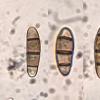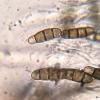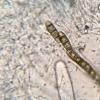
30-12-2025 16:44
Pascal DucosBonjour,Une anamorphe rose stipitée, très nombre

30-12-2025 17:14
 Bernard CLESSE
Bernard CLESSE
Bonjour à toutes et tous,Pourriez-vous aider Albe

29-12-2025 10:15
Hulda Caroline HolteHello, I found and collected this propoloid ascom

30-12-2025 09:04
Hello.A Pyrenomycete sprouting sparsely but very d

29-12-2025 17:44
Isabelle CharissouBonjour,J'aimerais savoir si d'autres personnes au

12-11-2021 00:03
Lepista ZacariasHi everybody,A week ago in my fiels trip I noticed

29-12-2025 17:12
 Bernard CLESSE
Bernard CLESSE
Bonjour à toutes et tous,Pourriez-vous m'aider à
Hysterium pulicare (?)
Ethan Crenson,
04-04-2018 16:05
From Bronx NYC, Pelham Bay Park on Picea. Am I correct that this is Hysterium pulicare? Ascospores are brown, 3-septate, (18) 21-24 by 6-8µm. The end cells of most spores are lighter brown (a few almost hyaline) than the median cells.
The difference between H. angustatum and H. pulicare in Boehm's key depends on this feature: "terminal cell mainly remaining hyaline". He also writes that ~10% of ascospores of H. pulicare are typically found to be concolorous; and ~5% of ascospores of H. angustatum are found to be versicolorous.
Ascospore size for H. pulicare is worth mentioning as well. H. pulicare ascospores can reach up to 40µm in length according to Boehm and Zogg. I did not observe anything approaching 40µm.
So my questions regarding my collections boil down to: Are the end cells light enough to place it in H. pulicare? Does the absence of ascospores in the larger range (near 40µm) eliminate H. pulicare as a possibility?
Thanks in advance!






